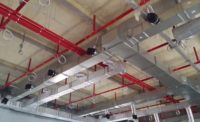One of the primary objectives of the model building codes is to minimize the impact of fire, including reducing to the greatest extent possible the spread of fire and smoke floor-to-floor. This objective is achieved using a combination of building fire safety features, including passive fire/smoke separations and pressurization smoke control systems. Pressurization systems may include stair pressurization, elevator pressurization, or zoned smoke control.
The design requirements for pressurization smoke control systems included in the International Building Code (IBC) and NFPA 92, Standard for Smoke Control Systems, specify a minimum and maximum pressure differential across smoke boundaries. The minimum pressure differential ranges are from 0.05 in H2O (sprinklered building) to 0.1 in H2O (non-sprinklered building or IBC stair pressurization), and are meant to counteract the anticipated buoyancy force resulting from a compartment fire adjacent to the stair, incorporating appropriate safety factors. The maximum pressure differential specified is 0.35 in H2O, and is derived from the maximum allowable opening force for doors entering the stairs, which is typically specified to be 30 lbf; however, it can be less in some jurisdictions depending upon the interpretation of ADA door opening force requirements during operation. The door-opening force must be low enough to allow the majority of building occupants to be capable of opening the door to the stairwell in an emergency event. Excessive force against the door could prevent occupants from entering the stairwell, which could be a dangerous condition even in the event of a small fire in a high-rise building.
In order to properly design pressurization smoke control systems in tall buildings, the vertical air movement through a building caused by the temperature differential between the conditioned building air and the ambient outside air, otherwise known as the “stack effect,” must be evaluated. During cold weather conditions, the stack effect causes air to move vertically upward in buildings. During very hot weather conditions, the stack effect causes air to move vertically downward in buildings. The vertical air movement under winter and summer stack effect conditions causes an increase in pressure between the shafts and the building interior. The resulting pressure differential resulting from stack effect increases the further away you are from the building’s neutral plane and is therefore greatest at the top and bottom floors of a building.
Designing stair and elevator pressurization systems within the code-specified pressure differential limits can be challenging, particularly for very tall buildings. Given the significant impact on the performance of pressurization systems, stack effect must be carefully considered in the design to ensure the system meets the intended fire safety objectives without compromising life safety by creating unacceptable door openings forces.
Stair Pressurization Systems
Stair pressurization systems typically utilize a single fan with a ducted shaft to multiple injection points or multiple fans distributed over the height of the stair. It is desirable to provide supply inlets every three to five floors to evenly distribute air throughout the stair, although stairs serving up to a maximum of 10 stories are capable of being pressurized via a single injection point.
In order to deal with the impact of stack effect on the design of stair pressurization systems in tall buildings, design engineers often propose to provide modulating stair pressurization systems that adjust the air flow into the stair based on measured pressure differentials between the stair and floors served by the stair. Components of a modulating system are typically a powered or barometric relief damper at the top of the stair, a stair pressurization fan equipped with a VFD and pressure sensors at multiple locations in the stairwell.
Modulating stair systems are difficult to test and commission, difficult to maintain, and have the potential to create unsafe conditions in the stair if not designed properly. For example, a common mistake is to modulate the stair fan to always maintain pressures above the design minimum pressure differential in the stair, using the lowest measured pressure differential from the various sensors installed at various heights throughout the stairwell. In a stack effect condition, modulating the fan based on a pressure sensor near the bottom of a stair would potentially cause unacceptably high door opening forces high in the stair. The fan may also ramp up due to an open door, creating pressures that would cause the door to slam shut when released, causing the potential for occupant injury. A proper design needs to specify a maximum fan setting to avoid over-pressurizing the stair enclosure.
Elevator Pressurization Systems
The IBC requires enclosed elevator lobbies in high-rise buildings, but allows the lobbies to be omitted when the elevator shaft is pressurized. The intent of the elevator pressurization is to keep smoke from flowing through elevator shafts and threatening life at locations remote from the fire. Elevator pressurization is a recent addition to the IBC and was offered as an alternative to providing lobbies, which often are not a desirable feature for architects seeking to maintain a more open floor plan or to maximize usable floor space. Other products such as the Smoke Guard smoke curtain product provide alternate solutions that can provide performance meeting or exceeding that of an elevator lobby with respect to minimizing the vertical movement of smoke.
The 2012 IBC requires that the elevator pressurization systems be in the range of 0.10 to 0.25 in H2O with the hoistway doors open on the ground floor. The upper pressure bound is meant to minimize the potential for elevator doors to fail to operate due to excessive pressure being exerted on the door, although reliable data for the maximum pressures under which elevator doors can operate is not readily available from the manufacturers.
Elevator pressurization systems typically require a large volume of air to obtain the required pressure differentials at the elevator doors since elevator doors can be substantially leakier than a stair fire door. Given that a typical elevator bank may include six to eight elevators in a high-rise building, the amount of pressurization air required can add up quickly.
Because it is common practice to recall elevators to a prescribed floor and to initiate elevator pressurization using an elevator lobby detector, the elevator shaft pressures have to be balanced considering the effect of the open elevator door(s) on the recall floor. The shaft leakage on the recall floor is much higher than the floors with closed doors due to the additional leakage around the perimeter of the elevator car opening. It can therefore be difficult to maintain the pressure differential on the recall floor.
Combined Systems
The fire protection community has many years of experience with pressurized stairwells designed to operate in the absence of pressurized elevators. When the two pressurization systems operate together, there is much more pressurization air entering the building, and after the air leaves the stairs and elevators it has to flow through the building to the outside. The large amount of pressurization air results in significant challenges for designers of combined pressurization smoke control systems. This is made even more complicated in jurisdictions such as California and Florida that require zoned smoke control in high-rise buildings that may involve exhausting or pressurizing the fire floors, adjacent floors, or portions thereof, to meet the desired objectives. Balancing the pressures created by the competing pressurization systems can be difficult, particularly when considering stack effect conditions.
When stair and elevator pressurization systems exist in combination for a building configuration where both the stairs and elevators connect to a common corridor (such as a hotel or residential building), the stairs and elevators can exert a back-pressure on each other that requires increasing the amount of pressurization air to meet the minimum pressure differentials between the stair/elevator shafts and the corridor. This may cause unacceptable door opening forces to be created between the corridor and hotel rooms/suites off the corridor, which presents a life safety hazard.
For open office plan buildings with tight curtain wall construction, the same effect can occur. In these cases, increasing the amount of pressurization air can create unacceptable door opening forces on floors with higher exterior leakage, such as the ground floor (due to the exits), mechanical floors, or open parking garage floors.
Another pitfall with combined systems is that during commissioning systems may be tested individually, with the pressures created being measured with only the stair/elevator/zone pressurization system activated. This testing may be adequate to test the functionality of the individual system’s equipment, but the measured pressures will not reflect the potential worst-case pressures that could be created when multiple systems are operational, which may be the case in a fire event.
It is possible that several different sequences of operations may need to be tested. As an example, a building’s fire alarm pull-stations may only activate stair pressurization, while elevator lobby detection activates stair and elevator pressurization. In some jurisdictions, additional smoke detectors or sprinkler water flow may activate a zoned smoke control system. For this example, all three alarm conditions represent a pressure state that needs to be tested, both in terms of minimum pressure and maximum pressure (as it impacts door opening forces). Use of a door opening force gauge during testing is therefore desirable in lieu of solely measuring pressure differentials, as pressure measurement may not adequately account for differences in door geometry or door closer force.
Buildings are almost always commissioned once at the time they are completed, and commissioning testing is not then repeated under different stack effect conditions. So it is possible for the sole commissioning to be done under spring-like conditions where there is near zero stack effect (due to the equilibrium between exterior temperatures and interior building temperatures). In this case, the pressurization system may be deemed acceptable with 29 lb of door-opening forces being measured across stair or exit doors. Ideally, for this case it would be necessary to retest the building under a winter or summer stack effect to make sure that the addition of stack effect forces would not cause the creation of unsafe door opening forces, or the systems to fail to meet the minimum pressures. Alternately, computer modeling or hand calculations could be performed to assess the expected performance under anticipated stack effect conditions.
Recommendations
Pressurization smoke control systems can be complicated systems to design, test, and maintain in buildings — particularly for very tall buildings, buildings in locations with moderate to extreme temperature fluctuations, and buildings with a combination of pressurization systems that could create competing pressure differentials that require extensive effort to balance. Here are several recommendations for steps to be included in performing testing of pressurization smoke control systems.
• Always measure both pressure differential and door opening forces across doors affected by pressure differentials, including all stair doors and doors used to access exit components (corridors, lobbies, etc.).
• Measure pressure differentials and door opening forces under all potential pressure conditions. Carefully scrutinize the fire alarm matrix/sequence of operations to determine all combinations of system operation that can create different pressure conditions in the building.
• Simplify the sequence of operations to the extent possible to minimize the number of pressure states and amount of equipment operating to achieve each pressure state.
• Specify that any pressure sensor used to modulate or otherwise control a pressurization smoke control system be maintained properly and sent out for periodic calibration.
• Should a modulating stair pressurization system be designed, hold open one door for two full minutes during system operation to simulate fire floor evacuation and test the maximum ramp-up of the system. Observe whether the door closes properly or slams shut, which is indicative of excessive overpressure in the stair.
• Pay careful attention to pressure differentials on garage/mechanical floors or other floors with openings to ambient, as these floors may have vastly different door pressures/forces than other floors of the building.
• For buildings where measured pressure differentials/door opening forces approach but do not exceed the required minimums or acceptable maximums, consider retesting under different stack effect conditions to accurately assess the potential for unacceptable conditions to occur.





